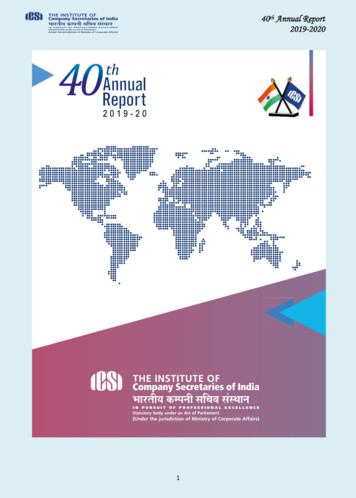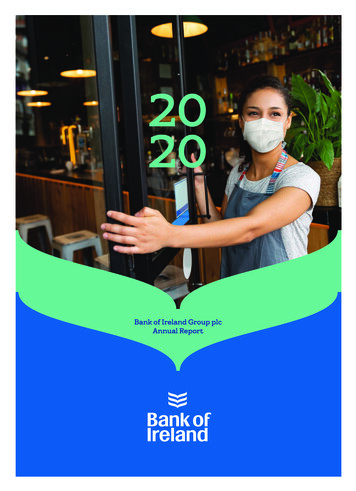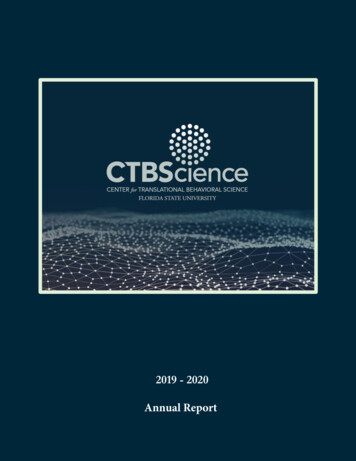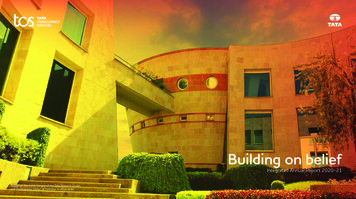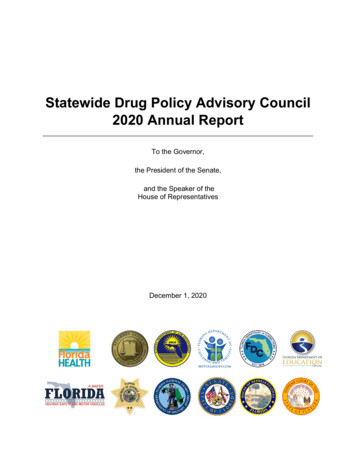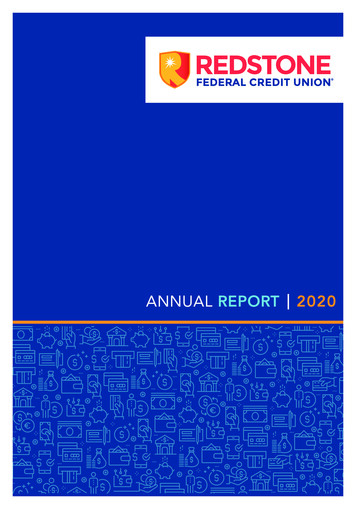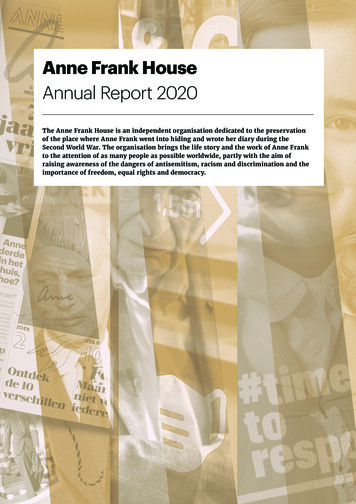
Transcription
Anne Frank HouseAnnual Report 2020The Anne Frank House is an independent organisation dedicated to the preservationof the place where Anne Frank went into hiding and wrote her diary during theSecond World War. The organisation brings the life story and the work of Anne Frankto the attention of as many people as possible worldwide, partly with the aim ofraising awareness of the dangers of antisemitism, racism and discrimination and theimportance of freedom, equal rights and democracy.
ForewordFor the last year and a half, the world has been going through an unprecedented crisis, which hashad an enormous impact on people everywhere and also on the Anne Frank House. As part of theglobal effort to stop the spread of the coronavirus, we had to close the museum doors three times in2020. Today, the museum is still closed and has been since the middle of December last. In 2019, wewelcomed 1.3 million visitors; in 2020, this number dropped to 396,779 visitors.In the 64 years of its existence, the Anne Frank House, an independent museum and educationalorganisation, has always never needed structural government support. However, in 2020, thedisappointing revenues from entrance fees forced us to take a series of painful measures. We hadto make organisational adjustments to reduce costs while ensuring that the core of our museumand educational mission could still be carried out. We had to say goodbye to almost a fifth of ouremployees.Fortunately, 2020 also had its highlights and successes. The Anne Frank video diary, whichwe launched with Every Media in March 2020, attracted no fewer than 6.5 million viewers. Wereceived a lot of positive feedback from all around the world. Thanks to leading actress Luna CruzPerez’s amazing performance, many young people felt a connection with Anne. In addition, theAnne Frank House opened its online doors with special educational workshops. These provided asuitable alternative for schools unable to visit the Anne Frank House due to the COVID-19 measures.Another success was the publication of the book Na het Achterhuis (‘After the Secret Annex’) by ourcolleague Bas von Benda-Beckmann in November. The book meticulously follows the conditions thepeople from the Secret Annex faced in the camps and how they died.On 1 June, we said goodbye to our managing director Garance Reus-Deelder, who started working atPlan Netherlands as its executive director. Garance worked at the Anne Frank House for over eightyears and made significant contributions to the organisation. We are very grateful to her for herdrive, knowledge, and commitment.Over the next few years, the number of activities will be reduced, but the urgency of our coremission has not changed, especially now, in the light of the pandemic. Fortunately, many peoplehave indicated that they consider the Anne Frank House and our educational work necessary. Weappreciate their input very much. We are also grateful to the government for the support we havereceived.Please take care of yourself and your loved ones.Ronald Leopoldexecutive directorAmsterdam, May 20212 Annual Report 2020
On 29 August 2020, Albert Gomes de Mesquita died at the age of90. Albert was a classmate of Anne Frank and shared his wartimeexperiences well into his eighties. ‘What really matters is eliminatingdiscrimination. Anything we can do towards that goal is good.’Albert was always ready to contribute his time to the Anne FrankHouse. Whether it was by telling his story to a class of children, doingan interview for the Anne Frank Magazine, or attending the openingof a new Anne Frank exhibition - we could always count on him.We are very grateful for everything he has done. The final time hehonoured one of our requests was on 12 June 2019, Anne Frank’s90th birthday. Together with Jacqueline van Maarsen, a friend andclassmate of Anne Frank at the Jewish Lyceum, he returned to AnneFrank’s former home at Merwedeplein to talk with young peopleabout Anne’s life and its significance for our times.The Anne Frank video diaryTogether with Every Media, the Anne Frank House developed the Anne Frank video diary: an onlinevideo series airing on YouTube and based on the diary of Anne Frank. In 13-year-old Luna CruzPerez, they found a girl who was able to deliver an enchanting interpretation of Anne Frank andwho translated Anne’s diary letters into diary videos in her own words.On 30 March 2020, the Anne Frank House and Every Media launched The Anne Frank videodiary, a new way to introduce young people worldwide to Anne Frank’s life story. The Anne Frankvideo diary consists of fifteen episodes and can be viewed in over 60 countries on youtube.com/annefrank.The video series is in Dutch and was initially subtitled in German, English, Portuguese, andSpanish. French, Hebrew, Japanese, and Russian were added later. The series got many views;in nine months, the counter reached 4.9 million views for the series and 770,000 views for theeducational videos.Watch the video diary on Youtube.com/annefrank.Anne films herselfThe Anne Frank video diary starts following Anne Frank on 29 March 1944. At that point, she is 14years old and has been living in hiding for over a year and a half, together with her parents Ottoand Edith, sister Margot, Auguste and Hermann van Pels, their son Peter, and Fritz Pfeffer. Annefilms herself and the events in the Secret Annex, looks back on the time before they went intohiding, talks about the war, and shares her deepest thoughts and feelings. The video diary ends on4 August 1944, the day on which Anne and the seven other people from the Secret Annex, as well astwo of their non-Jewish helpers, were arrested.3 Annual Report 2020
Jacqueline van Maarsen, Anne Frank’s now 91-year-old friend: ‘I’m excited about this video diary. Byreplacing the diary with a camera, young people can easily imagine being in the situation back then, whenAnne Frank lived. The idea took some getting used to, but I think it’s a good idea to transfer Anne Frank’sstory to these modern times.’Educational videosThe fifteen episodes of the video diary are accompanied by seven educational videos thatemphasise the fact that the video diary is based on a true story, and that deal with themes suchas discrimination, scapegoating, making choices, and freedom. The educational videos are alsoavailable in five different languages. Teachers can use the Anne Frank video diary and combine itwith the educational videos and other lesson materials.Personal and poignantRonald Leopold, executive director of the Anne Frank House: ‘The Anne Frank video diary is oneon-one, personal and poignant. Unlike the films about Anne Frank in which Anne is played byolder actresses and which take an outside perspective, young Luna uses her camera to invite theviewers to connect with Anne, the girl, in a direct way. I hope that many young people will bemoved by the video diary and that they will learn about Anne Frank’s life story and start to thinkabout antisemitism and discrimination today. I also hope that the video diary will encourage youngpeople to read Anne’s diary, her beautifully written diary letters, for themselves.’The Anne Frank video diary received rave reviews from press and audiences worldwide.I was watching this just before my onlineclass, and my eyes welled up. This girlbrings out the beauty in the darkest times.So, just now I was asked if I was doing allright and I immediately recommendedthis series to my English teacher!Comment from Sarah Louise on our YouTube channel.Lovie AwardsThe Anne Frank video diary won two Lovie Awards: a silver jury award and the people’s vote in thecategory Video: Entertainment and Sports. The jury announced the winners on 19 November 2020.‘Together we can keep Anne’s story alive,’ leading actress Luna Cruz Perez said at the Lovie Awardsvirtual award ceremony.4 Annual Report 2020
OrganisationThe Anne Frank Stichting was founded on 3 May 1957, with Otto Frank as one of the founders. Ithad the dual aim of preserving Anne Frank’s hiding place and opening it up to the public, and ofdrawing worldwide attention to Anne’s life story.The mission statement of the Anne Frank StichtingThe Anne Frank Stichting is an independent organisation that manages the place where Anne Franklived in hiding during the Second World War, and where she wrote her diary. The organisationaims to achieve global awareness of Anne Frank’s life story and her work in an effort to encouragepeople to reflect on the dangers of antisemitism, racism, and discrimination, and the importance offreedom, equal rights, and democracy.‘The organisation’s work is not limited to managing the House. It was set up to increase awareness of theevents of the dark years of the Second World War and the persecution of the Jews and to fight discrimination,prejudice, and oppression in the world today.’ Otto Frank in an interview with Basler Magazin in 1979Organisational adjustmentsThe corona pandemic has had significant implications for the Anne Frank House. The Anne FrankHouse depends on the revenues from museum visits and does not receive ongoing governmentfunding. As a result, it could not avoid making organisational adjustments.Ronald Leopold, executive director of the Anne Frank House: ‘The world is faced with a major crisis.Like many other organisations, we are going through a rough patch and cannot avoid taking drastic measures.Since the museum opened in 1960, visitors from all over the world have come to Amsterdam to visit the AnneFrank House. Entrance fees form the financial basis for managing and opening Anne Frank’s hiding placeand for carrying out our educational projects around the globe. The absence of visitors resulted in a collapsein revenues, which put severe pressure on our finances. We are grateful to the government for the support wehave received. Nevertheless, we are still dealing with substantial deficits. No one can say for sure how thepandemic will develop and what the long-term consequences will be. We need to adapt our organisation to thereduced revenues while ensuring that the essence of our museum and educational mission is upheld.’Three pillarsThe Anne Frank House implemented cost savings and started looking for additional income. Inaddition, it needed to draw on its reserves. The cost savings were realised in part by reorganisingthe workforce.Ronald Leopold: ‘We are having to let go a number of dedicated colleagues who have been with theorganisation for many years. The process is painful. We will carry out the reorganisation with the utmostcare. A good social plan has been put in place for those who are made redundant.’Board and organisationThe Anne Frank House adheres to the Governance Code for the Cultural Sector. The GovernanceCode for the Cultural Sector provides guidelines for the proper, responsible, and transparent5 Annual Report 2020
governance of and by cultural institutions as well as guidelines for supervision of their governance.The code applies to all Dutch subsidised cultural institutions. Please refer to the appendix for amore detailed explanation of the way in which the Anne Frank House complies with the eightprinciples of the Governance Code for the Cultural Sector.The museum is managed according to a Supervisory Board model, in which the Executive Boardis responsible for managing the Anne Frank House. The Executive Board is appointed by theSupervisory Council. The Supervisory Council supervises the Executive Board’s course of action andprovides advice.Supervisory CouncilThe Supervisory Council supervises all aspects of the organisation. The report of the SupervisoryBoard on the way the Board fulfilled its role in 2020, as well as the items that were on the agendafor the Supervisory Board meeting, can be found on the website.The Executive BoardThe Executive Board is responsible for managing the Anne Frank House. Ronald Leopold hasbeen the House’s executive director since 2011. Garance Reus-Deelder, who became the House’smanaging director in 2012, stepped down on 1 June 2020 to become Plan Nederland’s executivedirector. Ronald Leopold has taken over her duties.Remuneration policyThe Anne Frank House has its own terms and conditions of employment and, for the most part,observes the Museum CAO. The Executive Board is paid in conformity with the Governance Code forthe Cultural Sector. The members of the Supervisory Council and the Advisory Council are not paid.GDPRThe Anne Frank House values proper compliance with the GDPR. In our collaborations withother parties, for instance, we invariably use a so-called processing agreement drawn up inaccordance with GDPR guidelines. Our compliance is periodically assessed by an external party. TheSupervisory Board also receives a report about our compliance with the GDPR.Inclusion and diversityThe Anne Frank House adheres to the Code Cultural Diversity. In view of the objects clausecontained in the articles of association of the Anne Frank House and the House’s history, diversityand inclusion are essential values. Our recruitment policy was set up to secure a diverse workforce.Works CouncilThe Works Council represents the interests of the organisation and the employees of the AnneFrank Stichting and participates in discussions about proposed organisational developments. Newelections were held in 2020. Nine AFS employees ran for office, seven of whom were elected. In6 Annual Report 2020
2020, several topics were covered, the most important of which was the reorganisation of the AnneFrank Stichting.PartnersThe Anne Frank House collaborates with long-standing partner organisations in Argentina,Germany, Great Britain, Austria, and the United States. They host the travelling Anne Frankexhibitions and organise the accompanying educational activities in their countries.FinancesThe Anne Frank House does not receive ongoing government funding for the museum and largelydepends on the revenues from the entrance fees.For the funding of major museum renovations and educational projects, the organisationdepends on charity funds, donations, and subsidisers such as the European Union and the Dutchgovernment.Examples of project support— The Dutch Ministry of Health, Welfare, and Sports (VWS) supported thedevelopment and implementation of educational projects in the Netherlands forteachers and teachers in training, young people, the police, and for educationalactivities in professional and amateur football. In addition, they made it possiblefor a staff member of the Anne Frank House to participate in the InternationalHolocaust Remembrance Alliance (IHRA).— The Stichting 75 jaar vrijheid (‘75 Years of Freedom Foundation’) sponsorededucational interactive theatre performances for Dutch secondary schools andvocational schools (mbo), and additional workshops for students.— The Ministry of Foreign Affairs supported the presentation of the Anne Frankexhibition Let Me Be Myself in various countries. (Because of the coronavirus,these exhibitions were postponed.)— Veterans Affairs Canada, a programme of the Canadian government, co-fundedthe presentation of the travelling Anne Frank exhibition in Quebec, Ontario,Manitoba, and Alberta. (Because of the coronavirus, these exhibitions werepostponed.)— The VSB Fund made a financial contribution to the development and installationof a corona-proof outdoor version of the travelling exhibition Let Me Be Myself.— With the support of the Dutch agency of the EU programme Erasmus (thesubsidy programme European Solidarity Corps), two European volunteers wereplaced with the Anne Frank House for a year.— With the support of the Austrian Ministry of Social Affairs, an Australianvolunteer of the ‘Gedenkdienst’ worked at the Anne Frank House for a year.— The German Stiftung Erinnerung, Verantwortung, Zukunft (EVZ) supported theimplementation of the European online learning tool ‘Stories that Move’, aboutracism, antisemitism, and discrimination against Roma and Sinti, Muslims, andLGBT people.— Digital consulting firm SparkOptimus supervised the Stories that Move. Toolsagainst Discrimination project to help us reach a wider audience by providing theirexpertise free of charge. Companies and donors supported the crowdfundingcampaign for Stories that Move. Tools against Discrimination.7 Annual Report 2020
Income and expenditure2020 Balance Sheet and statement of income and expenditure can be found on pages 19 to 22.The management report and the annual accounts 2020 are available on our website.BankGiro LoterijSince 2007, the Anne Frank House has been an annual beneficiary of the BankGiro Loterij. TheStichting receives a fixed annual amount of 200,000. In 2020, we received an additional amountof 90,959, thanks to the BGL participants who indicated that they wanted to play for the AnneFrank House.8 Annual Report 2020
Anne FrankIn the museum, in our publications, and in our (online) exhibitions, we tell the life story of AnneFrank in the context of the persecution of the Jews and the Second World War.MuseumThe museum had to close its doors.As a result of the pandemic, the Anne Frank House closed its doors for the first time in March 2020.After being closed for more than two and a half months, people were able to visit the museumagain from 1 June. The Anne Frank House complied with the coronavirus protocol of the museumassociation, for instance by adapting the signs inside the museum in observance of the one-anda-half-meter distance, adopting additional hygiene measures and cleaning rounds, and reducingthe number of visitors per fifteen minutes. Since the international visitors stayed away, there wereenough tickets available, and many Dutch people seized the opportunity to visit the museum.After the summer, the number of COVID-19 infections flared up again, and the Netherlands wentinto lockdown from 5 to 18 November. After that, the museum opened for another month until thethird lockdown was implemented on 15 December. The Anne Frank House closed its doors again,this time for a longer period of time.Number of visitorsThe coronavirus crisis had major implications for the Anne Frank House. Visitor numbersplummeted due to the lockdowns and corona measures.In 2019, the Anne Frank House welcomed a record number of 1.3 million visitors; in 2020, thenumber sank to 396,779 visitors.9 Annual Report 2020
Educational and introductory workshopsIn 2019, 1,650 school groups from primary and secondary schools, teacher’s training colleges, andintermediate vocational schools participated in two-hour educational workshops in Dutch, German,or English. In 2020, there were only 316 workshops.Museum visitors can start off their visit with an introductory workshop of half an hour. In 2019, weheld 6,500 introductory workshops; in 2020, this number fell to 4,789. Still quite a high number, butwith fewer people per workshop, in compliance with the coronavirus measures.Evening visits for AmsterdammersOn Thursday evening 6 February and Friday evening 7 February 2020, the Anne Frank Houseopened its doors to Amsterdam residents. As in previous years, 2,000 Amsterdammers were invitedto visit the museum for free. Both evening sessions were booked up in no time.The visit came with an audio tour. Andthat was kind of fun because they wereactually reading aloud, bits from the diary,but also just information about herself. Inthis one fragment, she says for example:Dad, it’s 8:30, you really shouldn’t runthe water anymore. They had to be superduper quiet for two years.From the review of Naniki, a young teenager,on mocca.amsterdamAnne Frank House celebrates its 60th anniversaryOn Sunday, 3 May 2020, it was sixty years to the day since the Anne Frank House opened its doors tothe public on 3 May 1960. Otto Frank, Anne’s father and the only one of the eight people who had beenin hiding in the Secret Annex to survive the Holocaust, laid the foundation for the preservation andopening of the building at Prinsengracht 263: as a warning from the past, with an eye to the future.Otto FrankOtto Frank was the driving force behind the publication of the diary written by his daughter andbehind the opening of the Anne Frank House, his previous business premises and hiding place. Indoing so, he was assisted by a committee of prominent Amsterdammers. The Anne Frank Houseorganisation was established in 1957, and its main purpose was to preserve the hiding place andopen it up to the public. And to promote Anne Frank’s ideals in the process.On Sunday, 3 May 1960, the moment had come, and the Anne Frank House opened its doors to thepublic. During the opening, Otto Frank spoke emotional words of thanks: ‘I beg your forgivenessfor not speaking from this House after today. You will understand that the memories of everything thathappened here are too painful. I can only thank you all for the interest you have shown in coming here today,and I hope that you will continue to support the work of the Anne Frank House and the International YouthCentre, morally and in every other respect.60 years laterAfter the opening, the number of visitors to the Anne Frank House kept increasing almostcontinuously. From several tens of thousands in the first years to 1.3 million visitors in 2019. This10 Annual Report 2020
trend was interrupted in 2020. The Anne Frank House, which always opens every day of the year,except for Yom Kippur, now closed its doors for extended periods. For the first time in sixty years,visitors were not allowed inside Anne Frank’s former hiding place. The 60th anniversary of theAnne Frank House was commemorated online.Anne Frank’s 91st birthdayFriday, 12 June 2020, marked the 91st celebration of Anne Frank’s birthday. The Anne Frank House,which had opened again on 1 June, offered special introductory workshops, and every visitorreceived a special postcard. For young people, there was a meet and greet and a postcard signedby Luna Cruz Perez, who played Anne Frank in the Anne Frank video diary. On 12 June at 2 p.m.,carillonneur Boudewijn Zwart played a musical ode on the carillon of the Westerkerk in celebrationof Anne Frank’s birthday.‘I shall not remain insignificant; I shall work in the world and for mankind!’ Anne wrote in her diary on 11April 1944. Seventy-six years later, Anne Frank’s words and meaning are still as powerful as ever.BankGiro Lottery extends partnershipIn these corona-ridden times, the news was particularly welcome: the BankGiro Lottery extendedits partnership with the Anne Frank House for five years. The BankGiro Lottery supports artisticand cultural initiatives. In 2020, its cultural partners in the Netherlands received 83,491,428,thanks to the Lottery’s nearly 750,000 participants.Ronald Leopold, executive director of the Anne Frank House: ‘We are delighted with this collaboration.The BankGiro Lottery lends valuable support to our museum, as with the renovation of the Anne Frank Housein 2018, and it allows us to introduce the Anne Frank House and the story of Anne Frank to a wider audience.’OnlineThrough its social media platforms and the website annefrank.org, the Anne Frank House reachesmillions of people all around the world.Social mediaIn 2020, we noticed that our social media strategy was paying off. We increased our effortson Instagram and YouTube, essential channels for young people, by developing specific poststhat appealed to people on a personal level. Anne Frank is (usually) our point of departure. OnInstagram, the number of followers increased from 77,000 in 2019 to 137,000 in 2020, and onYouTube, the number of subscribers increased from 22,000 in 2019 to 135,000 in 2020. The AnneFrank video diary played a large role in the increase on YouTube. As a result, the total number ofviews of all videos on the channel rose significantly from 10 million to 18 million. Our Facebookfans remained loyal to our channel, and their numbers grew from 842,000 to 879,000 followers.#3 in the NetherlandsAt the end of the year, Somention presented the ‘Top 10 of the best Instagram account in theNetherlands’ for 2020, based on independent research. Only Dutch brands or international brandswith Dutch Instagram accounts were considered. The focus was on the engagement rate (thenumber of comments and likes per post divided by the number of followers) combined with thenumber of followers. The account of the Anne Frank House came third on the list.11 Annual Report 2020
WebsiteIn 2020, the website attracted 8.7 million visitors, who watched an average of 3.5 pages in 7minutes. Visits varied between 1.1 million in April and 0.5 million in December. Most of the visitorscame from the United States (2.3 million) and the Netherlands (0.9 million), followed by GreatBritain, Germany, Mexico, India, and Spain. As a consequence, the website was mainly (53%) readin English. 53% of the visitors accessed the site on their smartphones and 40% on their computers.About 15% of the visitors spent more time on the website, with an average of 31 minutes. Duringtheir visit, they typically looked at almost everything about Anne Frank.Kennisbank Online (Online Knowledge Base)The Anne Frank House researches the history of Anne Frank in the context of the Second World Warand the persecution of the Jews, and it has a wealth of information on the subject in the form ofbiographies, documents, photographs, film footage, research, and testimonies. We want to share allof this in-depth and layered information with our audience, and we want to do so in an innovativeand accessible way: through the Online Knowledge Base. In 2020, we applied for a grant with theMondrian Fund and were awarded the sum of 250,000. In 2021, we will start building the OnlineKnowledge Base.ResearchNew publication: After the Secret AnnexIn November 2020, the book Na het Achterhuis (‘After the Secret Annex’) was published by Queridopublishers. Based on in-depth archival research and the available testimonies, the book attemptsto reconstruct what happened to the eight people from the Secret Annex: Otto and Edith Frankand their daughters Margot and Anne, Hermann and Auguste van Pels, their son Peter, and Fritz12 Annual Report 2020
Pfeffer, after their arrest on 4 August 1944. By bringing together the available archival material,supplemented by witness statements and ‘circumstantial evidence’, the writer has made everyeffort to learn as much as possible about the camp experiences of these eight people. Moreover,he shows how the life stories of the main characters can be understood in the broader historicalcontext of genocide and persecution by the Nazi regime.ResearchBas von Benda-Beckmann, a historian who works at the Anne Frank House, wrote Na het Achterhuisand drew on the research into the camp experiences of the eight people from the Secret Annexconducted by the Anne Frank House since 2014. Bas von Benda-Beckmann: ‘The research providedseveral new insights. We now know that Anne and Margot probably died in early February rather than in lateMarch 1945, as had long been assumed. We publicised this finding in 2015. We have also learned more aboutthe deaths of Hermann van Pels and his son Peter. Hermann van Pels was almost certainly murdered in one ofthe gas chambers in Auschwitz-Birkenau on 3 October 1944, and Peter died in Mauthausen on 10 May 1945,five days after the camp was liberated. He was so close and only 18 years old. The meticulous study of theconditions under which the people from the Secret Annex lived in the camps and how they died made theirhistory even more tangible and even more painful.’de Volkskrant, 19 February 2021, 4 out of 5 stars: ‘Historian Bas von Benda-Beckmann, staff member ofthe Anne Frank House, has made an admirable attempt to reconstruct life after the Secret Annex. Admirable,because he has supplemented the lack of sources referring directly to the people from the Secret Annex withtestimonies of people with similar experiences. And when those testimonies are contradictory, or when thememories cannot be substantiated by other sources, Von Benda-Beckmann does not attempt to mask the gapsin the life stories.’13 Annual Report 2020
EducationOur educational programmes and products are designed to encourage young people to reflecton social developments, then and now, with a focus on prejudice, discrimination, racism, andantisemitism. These programmes and products are always based on Anne Frank’s life story.Tackling racism in footballIn early February 2020, the Royal Dutch Football Association KNVB, together with Minister BrunoBruins (Sports) and Minister Wouter Koolmees (Social Affairs), presented a plan to combat racismon the field. The racist remarks directed at Excelsior player Ahmad Mendes Moreira by Den Boschsupporters from the previous November were the last straw. The cabinet allocated 14 million eurosfor a period of three years for tackling racism in football.The plan consisted of several measures: punitive, criminal, and educational. The number of smartcameras in and around stadiums will be increased, and football clubs that do not take sufficientaction against racism may lose points and face fines. In addition, a special prosecutor will beappointed to fight racism in football, and offenders will be prosecuted more readily. In addition,the campaign Ons voetbal is van iedereen (‘Our football belongs to everyone) will be launched with theparticipation of influencers.Last but not least, two of the Anne Frank House’s educational projects are part of the plan: Fair Playworkshops and the Football Chanting Project.14 Annual Report 2020
Anne Frank Magazine‘Luna plays Anne’ read the headline of the 2020 Anne Frank Magazine. Through the Anne FrankMagazine, students in grades 7 and 8 of elementary school learn about the story of Anne Frank inthe context of freedom and liberty. This edition was dedicated to 75 years of freedom and offered aglimpse behind the scenes of the Anne Frank video diary.The article ‘Van democratie naar dictatuur’ (‘From democracy to dictatorship’) by Menno Metselaar,with illustr
Teachers can use the Anne Frank video diary and combine it with the educational videos and other lesson materials. Personal and poignant Ronald Leopold, executive director of the Anne Frank House: 'The Anne Frank video diary is one-on-one, personal and poignant. Unlike the films about Anne Frank in which Anne is played by


